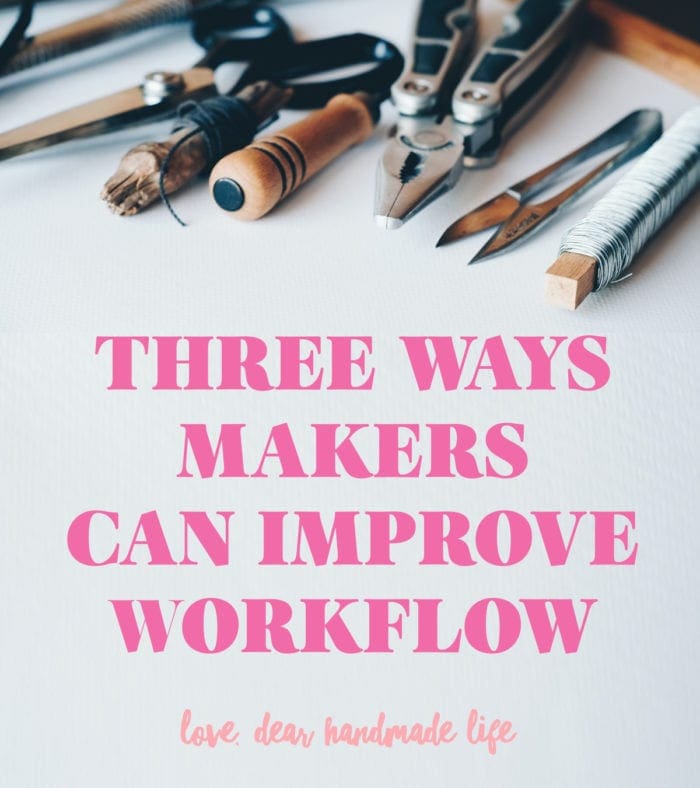3 Ways Makers Can Improve Workflow
Editor’s Note: Managing production may not seem like the most invigorating part of running your own business but, having systems in place to keep track of your inventory and create a schedule and map for production that minimize effort reduces error, wasted time and money and gives you more time to do what you’d probably rather be doing… designing and making things! Our friends at Katana specialize in helping makers make their production, well… more productive. They’re joining us with some tips below on improving workflow PLUS Katana is offering 30% off the first three months off your subscription. Simply visit the site and enter the promo code “HANDMADE” when setting up a subscription.
-Nicole S.
It doesn’t matter if you’re a faceless conglomerate, churning out products in mass batches or a quaint, humble, maker working out from your garage. If your workstation isn’t in order, you’re going to see delays and struggle to unite your goods with your customers. You might think this is an easy fix: a few Marie Kondo videos on YouTube and everything will be tidy.
You can find joy in getting organized, but improving your workflow takes time and effort. By focusing on these areas in particular, you’ll be able to optimize your business, meaning less stress for you and your customers.
1. Better Inventory Management
Inventory management isn’t just about understanding what’s on your shelves. But it’s managing your supply chain, order fulfillment, and fine-tuning the right number of products and material to keep in stock.
It might seem straight forward, but it’s crucial to keep the balance between what you stock and what you sell to gain the most value.
By getting your inventory management sorted, you will be able to:
- Reduce costs
- Optimize fulfillment
- Give better customer service
- Prevent loss from theft, spoilage, and returns
For example, let’s imagine a merchant is selling on Shopify. If they take the time to optimize their inventory they can set reorder points, allowing them to avoid stock-outs and building dead stock which can drain revenue from the company. Having this safety stock gives them more control over their Shopify inventory management.
2. Make a Master Production Schedule
The master production schedule (MPS) is a must-have for every manufacturer, it’s the ultimate to-do list. Having your master production schedule is essential for making your workflow more efficient and will tell you what you need to produce, how much, and when you need to get it done. The quicker you get your master production schedule made, the quicker you’ll be able to keep your commitments with customers. You might be doubtful if you’re working on your own. But if you get into the habit of having an MPS now, it will help you later when your business starts to grow.
Here is what you need when putting together your master production schedule:
- A list of your products
- A variation sub-list for your products
- The production quantities for a production period
3. Use Routing Manufacturing to Minimize Delays
Routing manufacturing is your map around the shop floor. The good thing about this map is that you can move your workshop around to find the most effective route. The idea is you place all your tools and materials in the most appropriate places to achieve the smoothest workflow.
Wondering how to do this? Take each of your products, then figure out what tasks and tools you need to finish the item.
To simplify it:
Routing = The tasks and the order you need to do to make your final product.
If you make all your products the same way, then reconfiguring your workshop may not be necessary. Although, it is still worth examining your current set up to make sure you’re eliminating as much waste as possible.
When you’ve followed the above steps, you’ll finally have your routing document which will have:
- The tasks a product will pass through
- The set-up time
- The amount of time it takes to finish the product
Concentrating on better redesigning your workshop, developing a master production schedule and carefully monitoring your inventory management are quick ways to improve your workflow. But, this is only the tip of the iceberg. If you want to optimize your business, managing everything in spreadsheets isn’t going to cut it. Other small businesses solve this issue by using production scheduling software like the one offered by Katana.
This software allows you to:
- Improve inventory management
Katana’s unique auto-booking system takes available material and allocates it to your manufacturing orders. The drag-and-drop feature allows you to prioritize orders you need to complete first. The auto-booking system also redistributes allocated material to the new work order.
- Have the perfect master production schedule
Once you’ve organized your manufacturing the production scheduling software becomes your MPS. It automatically tracks and updates the progress of your jobs with an easy-to-read visual dashboard.
- Set up your routing manufacturing
Within a product card, you can assign tasks, resources, associated costs and time it takes to finish a product. This means that when you generate a manufacturing order this is all figured out ready for you.
Why not check it out for yourself? Katana is offering 30% off the first three months off your subscription. Simply visit the site and enter the promo code “HANDMADE” when setting up a subscription.





